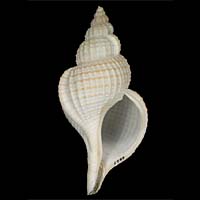|
< Previous family introduction |
|
|||||
 |
Family
Ranellidae
Tritons and Trumpet Shells
|
|||||
|
The family Ranellidae, previously known as Cymatiidae, are medium to large sized, heavy shells often with multiple varices, covered with a brown periostracum. The family has representatives from the intertidal down to abyssal depths, often with very wide geographical ranges. Several species which occur in NSW had previously been given local names, but it is now recognised that the species have a wider distribution. Hence names well established in Australia have been replaced by older European names, although the Australian names have been retained as subspecies in some cases. Intertidally, tritons and trumpet shells live on coral reefs or rocky shores, where they feed on a wide variety of invertebrate animals. On NSW intertidal rocky shores they are among the most prominent of the large gastropods. Cabestana spengleri is the most common, living at low tide among the cunjevoi (sea squirts) and under rocks, but numbers have decreased around Sydney due to human predation. The tritons and trumpets are carnivorous. Cabestana spengleri and Ranella australasia feed almost entirely on simple ascidians (sea squirts); Septa parthenopium feeds on bivalves as well as ascidians; Charonia lampas feeds on a variety of echinoderms. These species locate their prey by chemoreception of current-born prey substances. Charonia lampas is a nocturnal predator, while the other species mentioned feed at any time of the day. (Laxton, 1971) Family References:
In addition to the illustrated species, the following are recorded from NSW: Indo-West Pacific species, rare in NSW: (Roding, 1798). Indo-West Pacific; in NSW, known only from subfossil specimens dredged from Sydney Harbour. Cymatium occidentale (Morch, 1877) (Synonym Septa blacketi Iredale, 1936). Western Atlantic and Indo-West Pacific, to Angourie, NSW. Cymatiium cutaceum (Lamarck, 1816) (Synonym Linotella neptunea Garrard, 1963). Indo-West Pacific, to Brunswick Heads, NSW. Gyrineum lacunatum (Mighels, 1845) (Synonym Apollon facetus Iredale, 1936). Indo-West Pacific to Sydney, NSW. Species of southern Australian distribution, rarely found in the far south of NSW: (Angas, 1869). Twofold Bay, NSW, to Gulf St. Vincent, SA. Sassia verrucosa (Reeve, 1844). (Synonym Cymatiella peroniana Iredale, 1929). Green Cape, NSW, to south-western WA. Identification Notes Most members of the family bear a thick periostracum when alive. Although the periostracum itself is sometimes diagnostic, it must be removed to see the underlying shell surface. Shells of this family vary widely in shape, size and coloration with depth, usually becoming larger, more elongate and paler in deeper water. Denticulation of the outer lip is a useful feature in identification, but it is to be used with caution, as full denticulation is only developed in mature shells. Juvenile specimens frequently show a deep gutter inside the outer lip which becomes infilled as a toothed varix in adults.
|